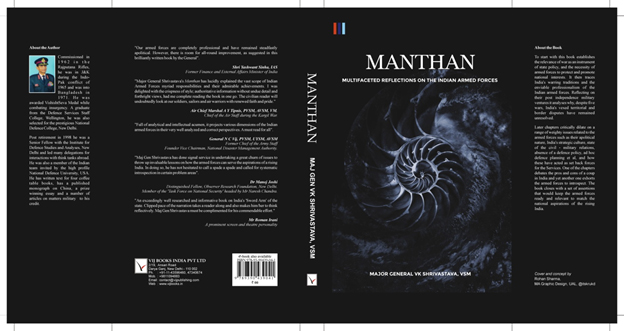Author: Maj Gen VK Shrivastava, VSM
Publisher: Vij Books India Pvt Ltd
Pages: 180 in hardcover
Price: 895/-
Manthan in Hindi means churning. It is a word that can be applied to India’s Armed Forces because they represent soldiers, sailors and airmen from every part of India, with all its communities and in which all communities are respected. The churning of this mix, for the British became a bonanza, as proved in World Wars I & II, when the Indian military component of 1.5 and 2.5 million respectively, was a major war-winning factor. Even 100 years after WW I (2014-2018), the role of Indian Army / Armed Forces personnel was recalled by Allied countries with much praise. After Independence, it was India’s great misfortune and indeed ironic that its first Prime Minister Jawaharlal Nehru viewed the Armed Forces with suspicion that they will take over the country. Much paranoia about this totally unfounded suspicion was generated resulting in a rotten foundation of civil-military relationship, so vital for India with its vast borders and threats, which Nehru was apparently quite clueless about.
One of the first strokes of the Nehruvian axe after Independence was to slash Indian Army’s numerical strength and salaries. Nehru and his favourite Defence Minister, V.K. Krishna Menon even meddled with the Army’s leadership and made a mess of handling the 1962 Chinese Aggression. Time has proved amply how wrong Nehru was, because the Indian Armed Forces, despite deficiencies of equipment, became a very solid nation-guarding and nation-building bastion which, indeed all the more, ranks as out of the best in the world till date. In 2020, the Chinese Peoples Liberation Army was again reminded of Indian Army’s lethality and its professionalism.
Coming in 2021, the 50th year since the 1971 Indo-Pak war resulting in liberation of Bangladesh, this book is timely. It has been followed by some books on the ’71 war and more are expected.
The author, with his rich experience of Army service including wars and counter insurgency / counter terrorism operations and a post retirement senior fellowship at the Institute for Defence Studies and Analyses, has, with his labour of love for India and the Indian Army, written an interesting and informative book of fourteen chapters. Naming them should tempt many to buy the book.
The chapters are titled: 1, “Political Violence”: An Interpretive Commentary on War; 2. “Rich Heritage” : The Noble Profession of Arms in India; 3. “Baptism by Fire” : Well Blooded Indian Armed Forces; 4.“Against All Odds” : A Resume’ of Operational Difficulties Faced in Prosecuting Post Independence Wars; 5. “Bash on Regardless” : Reflections on Combating Threats Within; 6. “The Boon” : Apolitical Indian Armed Forces; 7. “End Game” : The Curtain Raiser; 8. “End Game” : An Analytical Account of the Indian Endeavours; 9. “The Debate” : India’s Strategic Culture; 10. “The Bane” : Bureaucracy and the Troubled Civil-Military Relations; 11 “The Bogey” : Of a Coup d’ Etat in India; 12. “Dynamic Lethargy” : A Review of Defence Policy and Defence Planning in India; 13. “Mirror Mirror on the Wall” : Right Time for the Armed Forces to Introspect; 14. “The March Ahead” : Summative Parting Thoughts.
This concluding chapter has some futuristic assertions and suggestions so that the readiness and the capabilities of the Indian armed forces match the aspirations of a rising India as it strives to take its rightful place in the emerging world order.
This book ranges from being a must for all levels of officialdom related to national security, the armed/security forces, intelligence services and academics to Indians of all ages, who will be much better informed about India’s pre and post- Independence history swept under the carpet and still not taught in schools and above.
WordSword Features

The writer is editor WordSword Features. He is also a strategic analyst and former spokesperson, Defence Ministry and Indian Army, and can be contacted at wordsword02@gmail.











